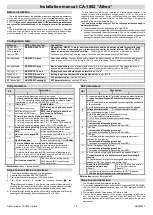
3.
Never use detergents or solvents to clean the alarm. Chemicals can permanently damage or temporarily contaminate
the sensor.
4.
Avoid spraying air fresheners, hair spray, paint or other aerosols near the alarm.
5.
Do not paint the unit. Paint may clog the openings to the sensing chamber and prevent the unit from operating
properly.
WARNING: DO NOT TAMPER WITH THE APPARATUS, AS THERE IS A RISK OF ELECTRIC SHOCK
OR MALFUNCTION.
Battery replacement
Remove the old batteries and replace with three LR6 AA batteries (Golden Power GLR6A, Duracell MN1500, Gold
Peak 15A and Energizer E91 AA alkaline batteries are recommended) when the LCD displays an "Lb" icon and the
yellow LED blinks once every 60 seconds with the buzzer chirping. After changing the batteries, reinstall your alarm,
and test your alarm by pressing the TEST/HUSH button.
NOTE: Rechargeable batteries are not recommended for use with this device.
Limitations of CO Alarms
1.
CO alarms may not wake up all individuals. If children or others do not readily awaken to the sound of the CO
alarm, or if there are infants or family members with mobility limitations, make sure that someone assists them in
the event of an emergency.
2.
This CO alarm will not sense carbon monoxide that does not reach the sensor. This CO alarm will only detect CO
that reaches the sensor. CO may be present in other areas. Doors or other obstructions may affect the rate at which
CO reaches the CO alarm. For this reason, if bedroom doors are usually closed at night, it is recommended that you
install a CO alarm in each bedroom and in the hallway between them.
3.
CO alarms may not sense CO on another level of the house. For example, a CO alarm on the second level, near the
bedrooms, may not sense CO in the basement. For this reason, one CO alarm may not give an adequate warning.
Complete coverage is recommended by placing CO alarms on each level of the house.
4.
CO alarms may not be heard. The alarm buzzer noise level is over 85 dB at a distance of 3.28 feet (1 meter).
However, if the CO alarm is installed outside the bedroom, it may not awaken a sound sleeper or one who has
recently used drugs or has been drinking alcohol. This is especially true if the door is closed or only partially open.
Even persons who are awake may not hear the alarm horn if the sound is blocked by distance or closed doors. Noise
from traffic, stereos, radios, televisions, air conditioners, or other appliances may even prevent alert persons from
hearing the alarm horn. This CO alarm is not intended for people who are hearing impaired.
5.
CO alarms are not a substitute for a smoke alarm. Although fire is a source of carbon monoxide, this CO alarm does
not sense smoke or fire. This CO alarm senses CO that may be escaping unnoticed from malfunctioning furnaces,



































